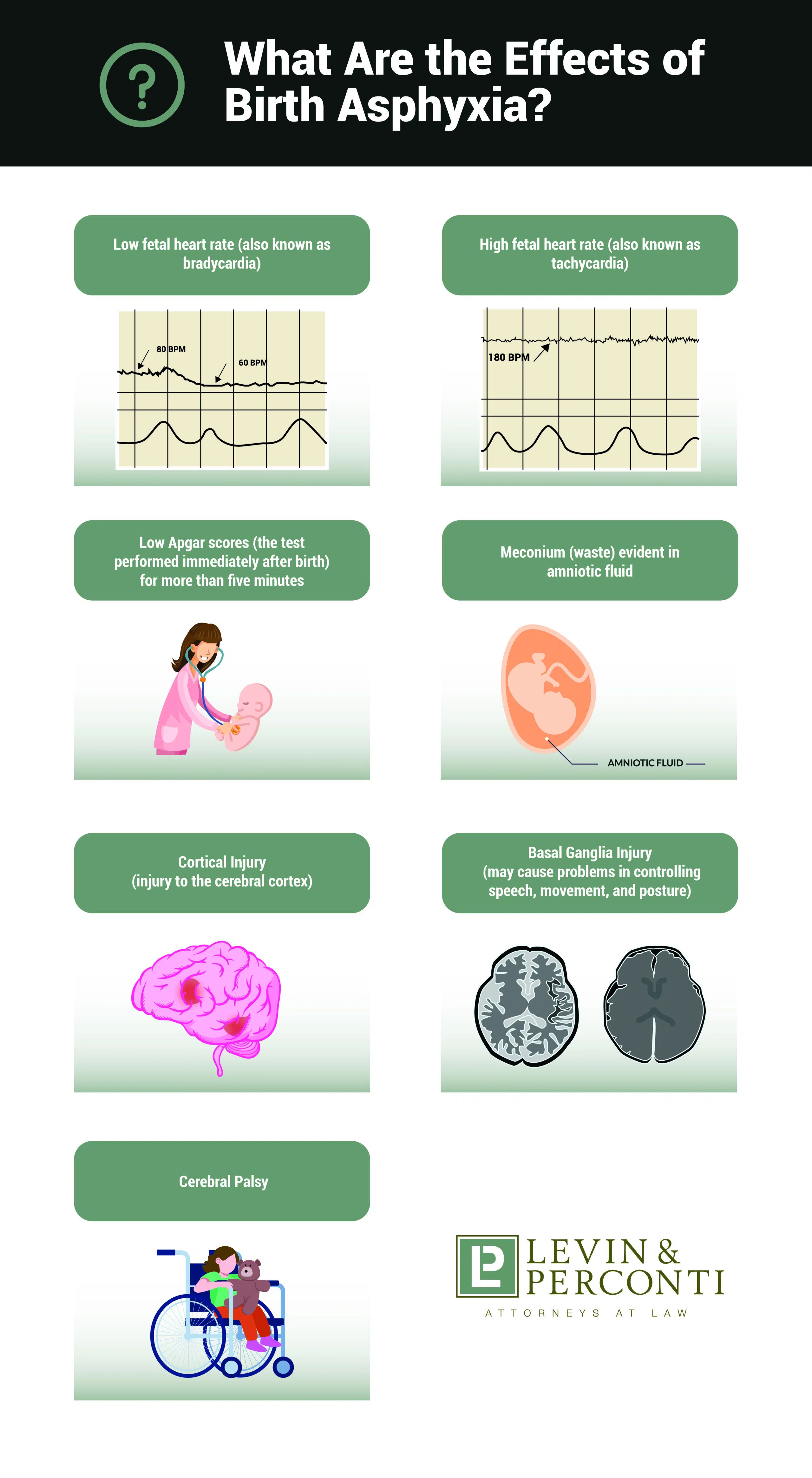Birth Asphyxia Lawyer
Around the world, an estimated 23% of neonatal deaths occur due to birth asphyxia. The condition, marked by a lack of blood flow and oxygen to the brain at birth, causes as many as one million deaths each year. Birth asphyxia can also lead to a host of health complications, many of which could cause suffering for the child and hardship for their family. If your child was the victim of birth asphyxia due to the negligence of a doctor or medical care provider at birth, you might have the right to compensation for your child’s injuries.
- What Is Birth Asphyxia?
- What Causes Birth Asphyxia?
- How Common Is Birth Asphyxia in the U.S.?
- What Are the Effects of Birth Asphyxia?
- What Should I Do if My Baby Suffers From Asphyxia?
- What Type of Compensation Is Available?
- Who Is Liable for Birth Asphyxia Injuries?
- How Can a Birth Asphyxia Attorney at Levin & Perconti Help Me?
- How Do I File a Claim for Birth Asphyxia-Related Injuries?
- Testimonials
What Is Birth Asphyxia?
Asphyxia occurs when the body lacks oxygen, usually to the point of fainting or unconsciousness. Specifically, birth asphyxia occurs when a baby’s body and brain lack oxygen or blood flow before, during, or after childbirth. An estimated 15.1% of newborns experience some type of birth (or perinatal) asphyxia.
By appropriately monitoring the fetal heart rate during labor, doctors, midwives, and nurses can limit the risk of the fetus developing asphyxia.
What Causes Birth Asphyxia?
Many conditions can limit oxygen supply to the baby during delivery. Birth asphyxia can occur due to:
- Early placental separation (also known as placental abruption), when the placenta separates from the uterine wall before the baby is born
- Long labor or delayed delivery
- Excessive uterine activity
- Overuse of oxytocin (also known as Pitocin)
- Umbilical cord problems, including umbilical cord compression and prolapse
- Placental insufficiency
- Maternal blood pressure problems, including preeclampsia (extremely high blood pressure caused by pregnancy) or very low blood pressure
- Infections (including chorioamnionitis, a bacterial infection occurring before or during labor)
- Shoulder dystocia
- Prolonged incision to delivery during a cesarean section
- A blocked airway in the fetus
- Anemia in the mother or child
Your health care provider may refer to birth asphyxia as fetal distress or non-reassuring fetal status. Birth asphyxia is the result of the baby not receiving adequate oxygen before, during, or just after labor. Your health care provider should properly monitor and diagnose the cause of fetal distress symptoms to avoid significant problems for infants during delivery by adjusting birthing plans or remedying the root problem, including birth asphyxia if relevant.
During labor and delivery, medical practitioners are responsible for monitoring both the mother and infant and intervening when necessary. Certain indicators may prompt doctors to perform an emergency C-section or an assisted delivery with forceps or vacuum extraction to protect fetal and maternal health. Failure to monitor the mother and baby or provide treatment promptly could leave the medical staff liable for complications their patients and newborns suffer.
How Common Is Birth Asphyxia in the U.S.?
In most developed countries, birth asphyxia occurs in approximately two per 1000 births. Infant mortality rates for all causes are highest in states like Alabama, Mississippi, South Carolina, and Louisiana. Between 15% and 20% of infants affected by perinatal asphyxia die in infancy. Around 25% of survivors will have brain damage that may affect them for the rest of their lives.
What Are the Effects of Birth Asphyxia?
Birth asphyxia can cause short- or long-term effects to your child’s health. Signs and symptoms of birth asphyxia include:
- Low fetal heart rate (also known as bradycardia)
- High fetal heart rate (also known as tachycardia)
- Weak muscle tone and lack of movement
- Depressed breathing, including gasping or struggling to breathe
- Low Apgar scores (the test performed immediately after birth) for more than five minutes
- Meconium (waste) evident in amniotic fluid
- Pale or bluish skin
- Seizures
Babies may show signs of birth asphyxia immediately or sometime after birth. The affected child may present with neurological challenges, including failure to meet milestones like rolling over, sitting up, babbling, or grasping objects. A physician may immediately order treatment if they diagnose asphyxia at the time of birth. Treatments might include body cooling (also known as therapeutic hypothermia), breathing tube insertion, or medication. Birth asphyxia can also lead to certain long-term health problems, including:
- Blindness
- Cerebral palsy, a group of motor disabilities that cause weakness or stiffness in the muscles
- Seizure disorders
- Learning disabilities, including dyslexia (problems with reading), dyscalculia (problems comprehending numbers and arithmetic), or problems with speech and communication
Sometimes, babies can make a full recovery from birth asphyxia and some of the associated birth injuries. However, many of the severe complications associated with birth asphyxia can complicate life for both the child and their family.
What Should I Do if My Baby Suffers From Asphyxia?
If your baby suffered a serious birth injury due to asphyxia, there are steps you can take to help protect your child and recover compensation for their injuries.
- Have your baby evaluated. You may need to visit your pediatrician and additional specialists to learn what complications your baby is possibly facing.
- Start early intervention to support your baby through any difficulties. These programs are often available through the state and can help provide vital support and treatment for your child’s disabilities. Early intervention may include speech therapy, physical therapy, or occupational therapy.
- Seek legal counsel. A lawyer can help clarify your family’s rights and determine the amount of compensation your family may be eligible to seek.
What Type of Compensation Is Available?
In most cases of birth asphyxia, the fetus shows apparent signs of respiratory distress during delivery, but medical care providers may not recognize the signs or provide adequate intervention. In such a case, you might have the right to seek compensation for your child’s injuries. It is important to contact an attorney as soon as possible to help determine next steps and if you are eligible for compensation. A successful medical malpractice lawsuit can result in the recovery of various types of damages.
You may be able to receive compensation for:
- Economic Damages
- Past and future medical bills incurred because of your child’s injuries
- Lost wages
- Funeral expenses
- Non-Economic Damages
- Physical pain and suffering
- Emotional distress
- Loss of quality of life
Your child’s pain due to medical negligence is a weighty emotional, practical, and financial burden. A medical malpractice claim can help you pursue monetary justice for those losses. Note that damages may differ depending on your jurisdiction, but a medical malpractice attorney can help determine what damages you’re eligible to receive.
Who Is Liable for Birth Asphyxia Injuries?
In birth asphyxia cases, liability depends on who oversaw your labor and delivery and what caused your infant’s injuries. You might have the right to file a birth injury lawsuit against:
- A doctor or midwife who failed to properly monitor your baby during the pregnancy
- A doctor, midwife, or nurse who failed to properly monitor your labor and delivery and intervene when necessary
- The hospital where your child’s birth injury occurred, particularly when a staff member’s negligence led to your child’s permanent injury
- An alternate care provider who failed to intervene when you started showing signs of pregnancy complications (separate from the medical staff overseeing your labor and delivery)
- A doctor, respiratory therapist, or nurse who failed to provide appropriate care to your baby after delivery
How Can a Birth Asphyxia Attorney at Levin & Perconti Help Me?
If you want to file a birth injury lawsuit, an attorney specializing in birth injury claims can help. At Levin & Perconti, we have a strong track record of success, earning millions in compensation for families enduring the repercussions of medical malpractice.
A birth injury lawyer can help:
- Collect the evidence you need to establish your claim
- Identify the compensation your family might be entitled to request
- Fight for your family’s best interests and to protect your legal rights as you deal with the insurance company and the hospital
A birth asphyxia attorney can help hold the responsible parties accountable, and fight for the financial security your family needs. Our lawyers at Levin & Perconti provide free consultations to evaluate your claim and help determine your legal options for the best possible outcome for your child and family.
How Do I File a Claim for Birth Asphyxia-Related Injuries?
If your child suffered brain damage or another permanent injury related to birth asphyxia, you might be eligible to file a medical malpractice claim. You must file your claim before the birth injury statute of limitations runs out, which varies based on the state your child was born in and other factors. We recommend reaching out to an attorney as soon as possible to make sure this statute does not pass, barring you from legal action.
Contact Levin & Perconti today to schedule your free consultation and learn more about how we can help you.
Also read:
Testimonials
Not only were they so professional but also so caring and thoughtful. It was very difficult going over the facts in our mother's case but they were so compassionate and understanding and allowed us to be with them every step of the way. We were able to sit in on the depositions and we were really able to see how hard they worked on our behalf.
During that time, my family and I suffered the loss of my mother. Mr. Levin and Mr. Perconti were more than just our lawyers. Words can’t really express our gratitude.
They were most patient and responded timely to many questions throughout the entire process. All demonstrated professionalism and extensive knowledge of case and state laws. Their in-depth investigative work uncovered details which were unknown to us and yet sadly confirmed our suspicions. We would recommend the Levin and Perconti Law firm and especially this team.
Margaret’s representation, guidance, and professionalism gave us the sense that we could put our trust in Levin & Perconti and the final outcome proved that to be true.
Legally Reviewed by

Dov Apfel
Contact Us
- Free Consultation
- (312) 332-2872
"*" indicates required fields
Related Pages
- Birth Injury Lawyer
- Birth Asphyxia
- Brachial Plexus Injury
- Breech Birth Complications
- Cerebral Palsy
- Erb's Palsy
- Gestational Diabetes Misdiagnosis
- Hypoxic-Ischemic Encephalopathy (HIE)
- Neonatal Seizures
- Oxygen Deprivation
- Preeclampsia Misdiagnosis
- Shoulder Dystocia
- Statute of Limitations by State
- Stillbirth Lawsuit
- Umbilical Cord Compression
- Untimely C-Section
- Vacuum Extraction Injury
Notable Results
SETTLEMENT
for the family of a child who suffered brain injury due to lack of oxygen during her birth
SETTLEMENT
for a child who suffered brain damage causing cerebral palsy as a result of a family practice physician's failure to perform a timely C-section
VERDICT
for a child who died as a result of a doctor’s failure to diagnose the mother with an immune disorder while pregnant
Birth Injury Awards
In 2024, Michael Bonamarte, Seth Cardeli, and Cari Silverman won the Trial Excellence award at the Jury Verdict Reporter reception and awards ceremony for their groundbreaking $40 million verdict on behalf of a client who suffered a birth injury. This is the highest ever reported medical malpractice verdict outside of Cook County, IL at the time of reporting and the highest ever verdict in Coles County.
Our Office
325 N LaSalle Dr Suite 300
Chicago, IL 60654
312-332-2872
